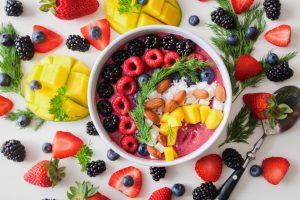Basal metabolism
We need a constant input of food energy to keep our internal organs functioning and to allow us to move – this is called our basal metabolism.
For mammals, Mb ≈ 50 (A/m2) W; for humans, surface area A ≈ 1.7 m2, i.e. ~ 85 W for sleeping
Fast walk or cycle (20 km/h): M ~ 700 W
Overall mean M ~ 100 – 150 W (2000 – 3000 kcal/d)
Where does this energy come from?
Most of the energy required for agriculture comes from sunlight, right? Wrong. Most of the energy comes from burning oil.
The usable energy content of beef and bread is about 2500 kcal/kg or 10 MJ/kg (+/- 30%). For chicken and fish the number is about half that [note] Beef calories and nutrients, https://www.freedieting.com/calories-in-meat [2019-10-04].[/note] [note] Peter Rez, Simple Physics of Energy Use, Oxford UP 2017.[/note]
Overall for a typical Western diet, the ratio of embodied energy of the food to the dietary energy in the food $r$ is about 6, i.e. for every joule (or calorie) of dietary energy, six joules (or calories) of oil have been burned. The ratio for vegetables is generally more favourable; that for meat (especially beef) is much worse. However, the picture is complicated, as can be seen from a British study by David Coley et al.[note] Coley, D., Goodliffe, E. and Macdiarmid, D. (1998) The Embodied Energy of Food: The Role of Diet, Energy Policy, 6, 455–459.[\note]:
- Baked beans $r \approx$ 10
- Sausages $r \approx$ 10
- Yoghurt $r \approx$ 9
- Beef $r \approx$ 8
- Pork $r \approx$ 6
- Eggs $r \approx$ 6
- Pasta $r \approx$ 4
- Rice $r \approx$ 3
- Milk $r \approx$ 3
- Potatoes $r \approx$ 2
- Bread $r \approx$ 1
Note however, that these figures are highly variable, depending on circumstances.
What about Animals?
The metabolic rate, $\Gamma$, for animals is related to the mass of the animal by Eqn.1:
$\Gamma = 4 M^{3/4} \tag{1}$
Such a relation where a physical property of an animal scales with mass to some power that is not unity is called an allometric relation[note] Ahlborn, Zoological Physics, p.12-16 , Springer, 2004[/note]. It is obvious that an elephant which is large and consumes vast amounts of food will have a larger metabolic rate than a mouse that is much less massive and consumes much less. Considering, however, the metabolic rate per unit mass of these animals (Eqn.2):
$\dfrac{\Gamma}{M} = 4 M^{-1/4} \tag{2}$
we find to sustain itself an elephant needs less energy per unit mass than a mouse. This explains why even though elephants eat a larger quantity of food compared to mice, mice actually need to eat more compared to their body weight than elephants. Our goal is to understand how heat loss contributes to smaller animals having a higher metabolic rate per unit mass than larger animals.
As mentioned some of the energy generated inside an animal goes to heat which is radiated out through the surface area of the animal. The rate of heat loss is proportional to the surface area, while the mass of an animal is proportional to its volume. The rate at which heat is radiated per unit mass then is proportional to surface area per unit volume.
For simplicity, if we take an animal to be spherical with radius, $r$, then we can relate the heat loss per unit mass to size (Eqn.3):
$\frac{4 \pi r^{2}}{\frac{4}{3} \pi r^{3}} \propto \dfrac{1}{r} \tag{3}$
As animals increase in size the rate of heat loss per unit mass decreases and less energy is needed to sustain the animal per unit mass. It might appear an obvious advantage then to be a large animal. Large animals, however, still consume more energy on the whole than smaller animals so that they need more food. If food is not abundant larger animals cannot sustain themselves[note] Ahlborn, Zoological Physics, p.12-16 , Springer, 2004[/note].
In conclusion, larger animals have a smaller heat loss per unit mass and require less food per unit mass even though they eat larger amounts than smaller animals.
Updated (CEW) 2019-10-16
